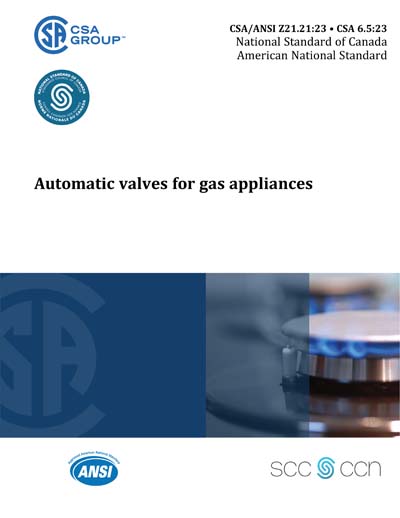Most recent
CSA/ANSI Z21.21-23/CSA 6.5-2023
Automatic valves for gas appliances
Preface This is the seventh edition of CSA/ANSI Z21.21 • CSA 6.5, Automatic valves for gas appliances . It supersedes the previous editions published in 2019, 2015, 2012, 2005, 2000, and 1995. The major changes to this edition include the following: a) removed the Figure on Class 125 cast iron pipe flange body connections; b) in Clause 4.4.5, revised flange connection requirements; c) in Clause 4.4.6, added coverage for additional flange connections; d) in Clause 4.10.2, added an additional date code option; e) in Clause 5.6.2.1, removed the capacity test for 85 to 110% of the manufacturer’s rated voltage; and f) in Clause 5.15, revised the nonmetallic materials test method. This Standard is considered suitable for use for conformity assessment within the stated scope of the Standard. This Standard was prepared by the Z21/CSA Joint Subcommittee on Automatic Gas Controls, under the jurisdiction of the Z21/83 Technical Committee on Performance and Installation of Gas Burning Appliances and Related Accessories, the Subcommittee on Gas Appliances and Related Accessories, and the Strategic Steering Committee on Fuels and Appliances. It has been formally approved by the Z21/83 Technical Committee and the Technical Committee on Gas Appliances and Related Accessories. This Standard has been developed in compliance with Standards Council of Canada requirements for National Standards of Canada. It has been published as a National Standard of Canada by CSA Group. This Standard has been approved by the American National Standards Institute (ANSI) as an American National Standard. Scope 1.1 Inclusions This Standard applies to newly produced automatic valves constructed entirely of new, unused parts and materials. These valves can be individual automatic valves or valves utilized as parts of automatic gas ignition systems. This Standard also applies to commercial/industrial safety shutoff valves herein after referred to as C/I valves. Components performing functions other than those of an automatic valve are to comply with applicable American National Standards or Canadian Standards. Compliance of an automatic valve with this Standard does not imply that the automatic valve is acceptable for use on gas appliances without supplemental tests with the automatic valve applied to the particular appliance design. A control that incorporates two or more automatic valves and no other function (as defined by the term combination control; see Clause 3) may be tested to this Standard or to ANSI Z21.78 • CSA 6.20, at the discretion of the manufacturer. 1.2 Exclusions This Standard does not apply to self-contained water heater, cooking appliance, or room heater thermostats, or self-contained automatic gas shutoff valves for hot water supply systems. 1.3 Types of operation The valve operator of an automatic valve can be actuated either directly or indirectly. In addition, it can be actuated by electrical means, by mechanical means, by means of a change of the absolute pressure of gas or air upon a diaphragm, or by other means. 1.4 Pressure ratings This Standard applies to automatic valves having maximum operating gas pressure ratings from 1/2 psi (3.5 kPa) up to and including 60 psi (413.7 kPa) and C/I valves having maximum operating gas pressure ratings of 1/2 psi (3.5 kPa) or greater (see Clauses 6 and 7). 1.5 Applicable gases This Standard applies to automatic valves for use with one or more of the following fuel gases: natural and propane gases. It is not applicable to corrosive and waste gases. 1.6 Mounting position This Standard applies to automatic valves that are to be mounted in the manufacturer’s specified upright position or in one or more of the optional mounting positions selected by the manufacturer. (See Clause 5.1.1.) 1.7 Pressure references All references to psi throughout this Standard are to be considered gauge pressures unless otherwise specified. 1.8 Additional provisions for the United States Additional provisions concerning electrical coverage applicable to units defined for use in the United States are outlined in Clause 9. 1.9 Additional provisions for Canada Additional provisions concerning electrical coverage, instructions, and markings applicable to units destined for use in Canada are outlined in Clause 10. 1.10 Terminology In this Standard, "shall" is used to express a requirement, i.e., a provision that the user is obliged to satisfy in order to comply with the Standard; "should" is used to express a recommendation or that which is advised but not required; and "may" is used to express an option or that which is permissible within the limits of the Standard. Notes accompanying clauses do not include requirements or alternative requirements; the purpose of a note accompanying a clause is to separate from the text explanatory or informative material. Notes to tables and figures are considered part of the table or figure and may be written as requirements. Annexes are designated normative (mandatory) or informative (non-mandatory) to define their application. 1.11 Temperature ratings This Standard applies to automatic valves that are capable of operation at ambient temperatures of 32 °F to 125 °F (0 °C to 51.5 °C), unless a higher temperature, lower temperature, or both, are specified by the manufacturer. (See Clause 5.1.2.) 1.12 Units of measurement In the US, the values given in US customary units are the units of record for the purposes of this Standard. The values given in parentheses are for information and comparison only. In Canada, the values given in SI units are the units of record for the purposes of this Standard.
Content Provider
CSA America, Inc. [csa]






